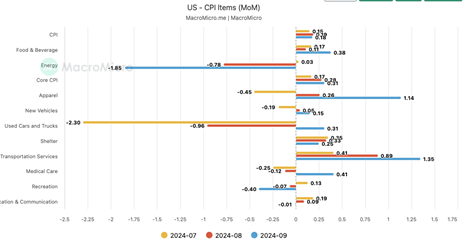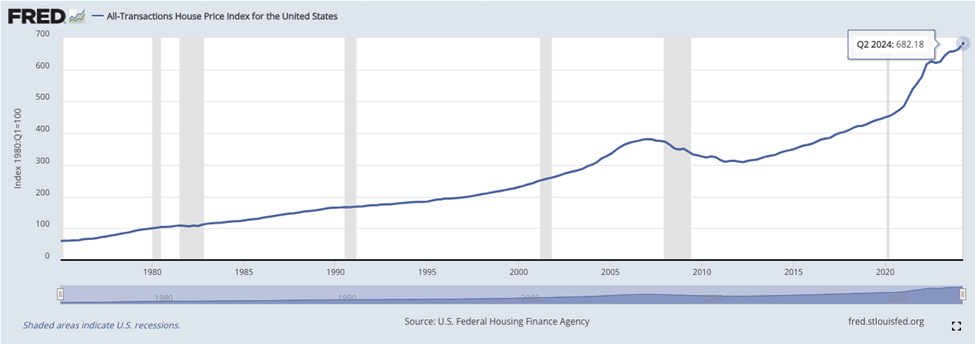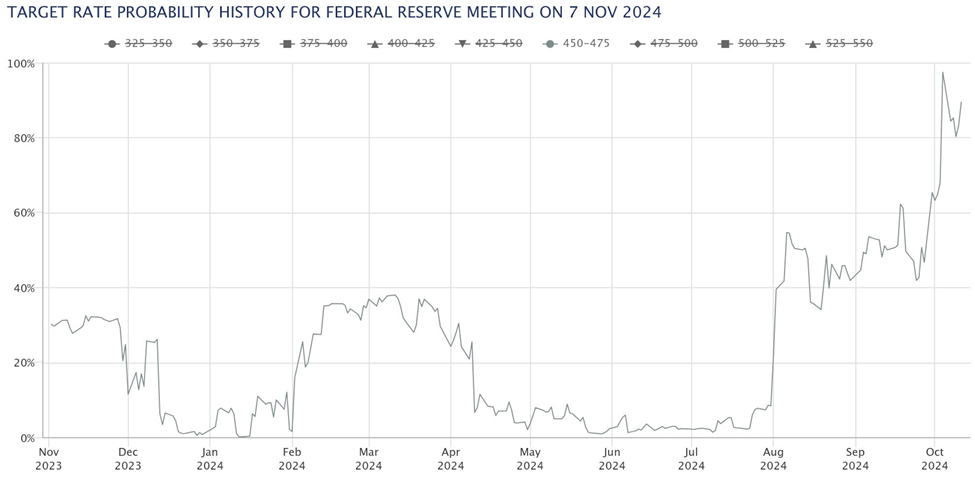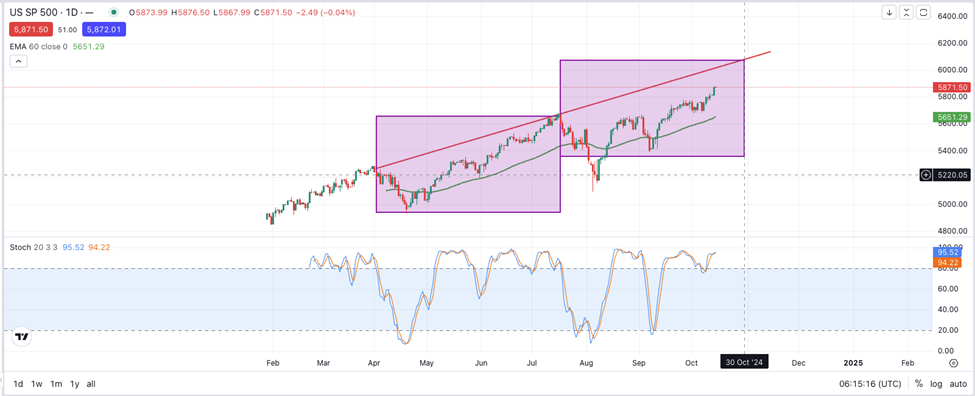Last week, the US Consumer Price Index (CPI) rose by 0.2%, bringing annual inflation to 2.4%, both 0.1 percentage points higher than expected. Initial unemployment claims also unexpectedly increased to 258,000, the highest since August, attributed to Hurricane Helene and the Boeing strike. Now Boeing announced 17,000 job cuts, or 10% of its workforce, moving temporary job loss to prolonged ones. (Source: Reuters) As hurricane-affected businesses may take months to recover, monitoring unemployment claims is crucial as they serve as a leading indicator of future unemployment rates. If claims continue rising, the unemployment rate could increase in the coming months, potentially putting pressure on the Federal Reserve to cut interest rates. Chairman Powell indicated the Fed may prioritise unemployment over inflation, based on recent reports.
Source: Tradingeconomics
To conduct an effective analysis of the Consumer Price Index (CPI), it's essential to consider the weight assigned to its various components. One significant factor is the medical care category, which accounts for 8% of the overall CPI calculation. Recently, this category has shifted from being a negative contributor to a positive one, highlighting its growing impact on inflation. (Source: CNBC)
Source: MacroMicro
Souce: US Bureau of Labor Statistics
The medical care component of the CPI captures changes in both out-of-pocket expenses for consumers as well as payments made by insurers to healthcare providers and pharmacies. The index is structured to reflect the evolving cost structures faced by consumers, incorporating payments at the time of care and health insurance premiums into its calculation.
Transportation services have also driven inflation, with the consumer price index for airline tickets increasing by 25% over the past year, including an 18.6% spike in April alone.
Shelter, which constitutes 37% of the CPI, remains the largest contributor. While 40% of U.S. households have mortgages, only 8% have adjustable rates, so rising interest rates have slowed new home construction and constrained supply, keeping home prices elevated and inflation becoming sticky.
Source: FRED
After the release of CPI and jobless data, market expectations shifted, with participants anticipating a possible 25-basis-point rate cut in November up to 94%. Broader factors, such as the US debt ceiling, Basel III implementation, and global economic slowdown, could pressure the Fed to continue cutting rates.
Source: CME group
Technical analysis
Source: Deriv X
The S&P 500 is in overbought territory, with resistance between 6018 and 6100. The next peak is expected between late October and early November, aligning with the US election, employment data, and the FOMC meeting.
Source: multpl
The chart shows the S&P 500 price-to-earnings ratio, which is historically high. Combined with a prolonged period of the manufacturing PMI below 50, it suggests the Federal Reserve will likely aim to manage market liquidity by cutting interest rates further.
Conclusion
As inflation stays elevated and unemployment claims climb, the Federal Reserve is likely to face increasing pressure to act more decisively, perhaps by cutting interest rates sooner rather than later.
The information contained within this article is for educational purposes only and is not intended as financial or investment advice. It is considered accurate and correct at the date of publication. Changes in circumstances after the time of publication may impact the accuracy of the information. The performance figures quoted refer to the past, and past performance is not a guarantee of future performance or a reliable guide to future performance. No representation or warranty is given as to the accuracy or completeness of this information. Do your own research before making any trading decisions.
Recommended Content
Editors’ Picks

EUR/USD stays pressured below 1.0900 amid risk aversion
EUR/USD remains under pressure below 1.0900 in the European session on Wednesday. The pair faces downward pressure due to a renewed US Dollar upswing, as risk sentiment falters on China concerns. Dovish ECB expectations also undermine the pair.

GBP/USD remains heavy near 1.3000 after soft UK inflation data
GBP/USD stays under bearish pressure near 1.3000 in the European session. The data from the UK showed that the annual CPI inflation declined to 1.7% in September from 2.2% in August, weighing heavily on the Pound Sterling.

Gold price advances to three-week top amid risk-off mood, bullish USD might cap gains
Gold price scales higher for the second straight day on Wednesday – also marking the fourth day of a positive move in the previous five – and climbs a three-week high, around the $2,677-$2,678 region heading into the European session.

Bitcoin holds onto recent gains, with $70,000 in sight
Bitcoin’s price stabilizes around $67,000 on Wednesday after rallying and breaking above a key resistance barrier on Tuesday. The rise in BTC comes after US Spot ETFs recorded a second straight day of inflows of over $373 million on Tuesday.

British inflation dips to 1.7% in September
And speaking of inflation and Europe, inflation in Britain not only fell below 2% in September but came in significantly lower than expected (1.7%y-o-y vs 1.9% expected).

Best Forex Brokers with Low Spreads
VERIFIED Low spreads are crucial for reducing trading costs. Explore top Forex brokers offering competitive spreads and high leverage. Compare options for EUR/USD, GBP/USD, USD/JPY, and Gold.






